| Article ID | Journal | Published Year | Pages | File Type |
|---|---|---|---|---|
| 2430378 | Developmental & Comparative Immunology | 2007 | 14 Pages |
A serine protease homolog (SPH) cDNA namely SPH516 was identified via a yeast two-hybrid screen between yellow head virus (YHV) proteins and hemocyte proteins of the black tiger shrimp Penaeus monodon. Initially, the C-terminal region of SPH516 (SPH516-C) was found to interact with a putative metal ion-binding domain (MIB) encoded by open-reading of frame ORF1b of the YHV genome. Subsequently, the full-length of SPH516 cDNA was obtained using 5′ rapid amplification of cDNA ends (5′ RACE) and it also bound specifically to the MIB domain only. Primers designed based on the SPH516 coding region amplified not only SPH516 but also an additional SPH named SPH509 from shrimp hemocytes using reverse transcriptase-polymerase chain reaction (RT-PCR). These new SPHs had high homology to MasSPH previously reported from P. monodon. All shared the same domain features including a putative signal peptide, glycine-rich repeat motifs, a clip domain, an HDG triad and a trypsin-like serine protease domain. It is interesting that these sequences were phylogenetically closer to a prophenoloxidase-activating factor (PPAF) from blue crab than to another SPH from the black tiger shrimp reported to be involved in cell adhesion. Our SPH transcripts were highly expressed in hemocytes and gills and were found to be down-regulated after YHV infection. Immunohistochemistry using a polyclonal antibody raised against shrimp protein SPH516-C heterologously expressed in Escherichia coli revealed that SPH516 was present almost exclusively in the shrimp hemolymph.
